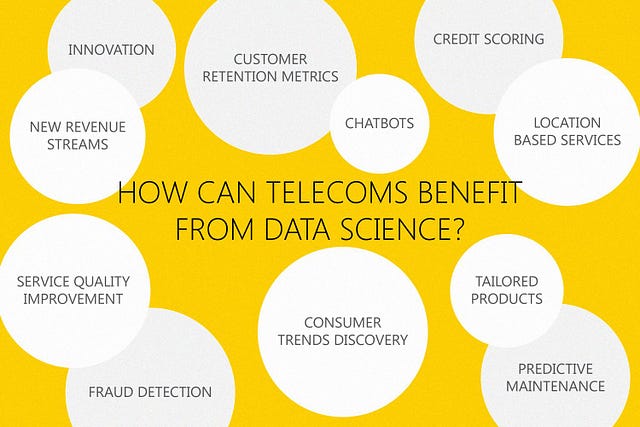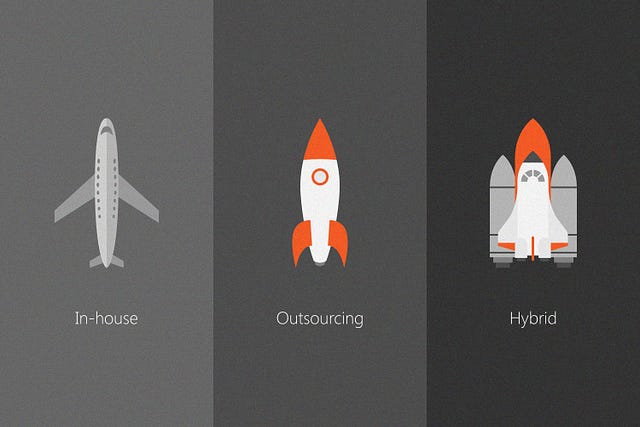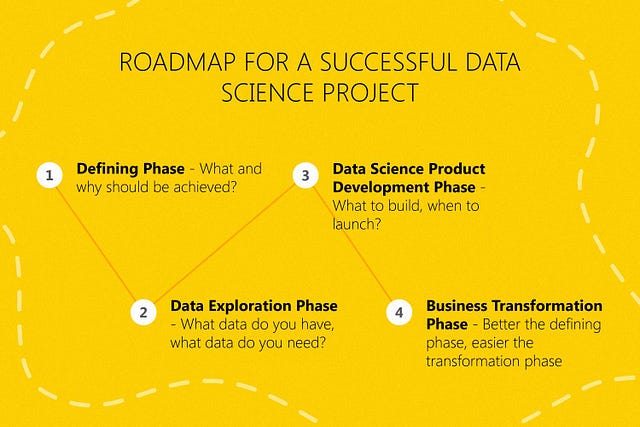If You’re a Telecom, Here’s Everything You Need To Know About Getting Into Data Science
The volume of data in today’s world is overwhelming, and as Gordon Gekko,the fictional character in the 1987 film Wall Street, put it “The most valuable commodity I know of is information.” Telecoms generate loads of data, and it seems all they have to do is to process it and extract useful information, and they’ll be on the top of the world. But is it really that simple?
This article explains why telecommunication companies should be interested in getting into Data Science, and how to get started with it.
First things first
Before we can start, we have to make clear what is Data Science.
Data Science (DS) is a blend of various statistical and data engineering tools, Machine Learning (ML) algorithms and predictive modeling principles with a goal to discover hidden patterns in raw data. It’s an exploratory methodology with the focus on analysing past or online data, and predicting the outcomes with an aim of making informed decisions. It answers the open-ended questions as to “what” and “how” events occur.
If we look at the telecommunication sector, we see the need to swiftly process the data to get valuable and deep insights. So how do the top telecoms use Data Science? In general the goals are to monetize data, find new revenue streams, be more effective and stand out in the crowd:

Although there are many ways telecoms can put Data Science to work in their favour, we´ll dwell on five of these, as they’re the ones with the biggest business impact.
TOP 5 ways how telecoms can use Data Science
No matter how you look at it, the telecom sector is under a lot of pressure. Startups can provide agile and on demand telecom-like services, OTT players have changed the way people consume the content, new business models and technologies are constantly disrupting the market.
To keep up with this pressure, telecoms are heavily investing into areas outside their core business, adding new value through their services and creating additional revenue streams to stand alongside their traditional commerce. In order to not be left behind and become just a mediator of innovative services, they’re adapting and adopting from emerging and innovative sectors.
Inspired by FinTech, telecoms invest in developing their own electronic payments, virtual credit cards and other online banking services. To do that they need Credit Scoring (assessing a person’s creditworthiness). Telecoms use it to decide on whether to extend (and to what extent) or deny credit. Credit scoring can be done based on telecom data alone or in conjunction with other data. For example, Telenor Group implemented an in-house credit scoring system which uses data such as frequency of top ups, phone change frequency (these things can serve as indicators of income level) and location data, which can reveal job stability, and other factors. Credit Scoring could also be used for a variety of other services that telecoms are offering like add-on sales, upsell, taylored services etc.
That brings us to customer retention metrics — improving upsell and cross-sell rate, win-back rate, NPS (net promoter score) and the holy grail — reducing customer churn. Using data science adds new dimensions and brings the game to a whole new level. Telecoms track and analyse all these metrics which help them to continuously improve and enrich customers connections with their brand. Using data science methods allows to leverage the data such as call center history, web logs, conduct sentiment analysis on both voice and text, and even crawl and use external data (data on competitors, their prices and offers, or information in the media).
Another popular area is chatbots, which improve customer experience by reducing the waiting time and making access to information easier for a customer. Using novel natural language processing techniques (for instance, based on neural networks), chatbots can simulate humanlike conversations with customers and even simulate a personality (e.g., warmth and trustworthiness).
Another use case is location based services (LBS) — services that integrate a mobile device’s location with other information to provide added value to a user. LBS can be used in a variety of contexts, such as population movement predictions, marketing, health sector, indoor object search, entertainment, work and personal life, etc. LBS is critical to many businesses to drive real insight from data tied to a specific location and/or device. For example, AT&T have analyzed their data to understand how people move through the city and provide this information to the municipality, which allowed to make a city greener, understand growth areas and bottlenecks.
Communications service providers (CSPs) also need to protect their business and customers by proactively conducting fraud detection. To attract more and more customers one needs to provide as intuitive user flow and business model as possible. On the flip side, it also attracts frauds and abusive users who’d like to take advantage of such a model. With the help of DS one can flag anomalous and suspicious patterns to prevent harmful actions.
How to get started with getting into data science?
It’s important to understand that Data Science is a mean to get to the goal, not the goal itself. It’s so easy to get caught up with the market pressure to be involved with Data Science, but the right mindset should be the purposefulness of the activities. DS is merely one way to reach the goal.
One of the most important aspects of DS project is to have a clear understanding what you would like to achieve and why.
You should ask yourself:
- What would we like to achieve?
- Does everyone understand what is the challenge?
- Does everyone understand why this is a challenge?
- Are you sure that what you’re asking for is what you really need?
- Is it achievable with DS?
- What are you hoping to get from the team?
- What data do you have?
- What is the timeframe?
- What are the parameters and how do measure it (metrics)?
- Other important aspect like define terms; question assumptions etc.
A good question will challenge your thinking and understanding.Questioning and learning are the key differences between doing data science and just looking at the data.
If you´ve now established an understanding that you might, or certainly need DS to achieve your goal, it’s also necessary to choose a right method. Which leads us to the next sizable dilemma — should you go with an in-house team or outsource?
Solving the in-house vs outsource dilemma

If you’re just getting started and DS in not your core business, it makes more sense to outsource the know-how. Because building internal DS department fast enough with the right competencies (Data Scientist, Data Engineer, Data Analysts, Data Architect, Head of Data Science etc) and experience, and to occupy these people with interesting projects, is unfortunately not something you can just do. It takes time and financial resources to build up a team (and team spirit). Usually both these resources are kept in rather tight leash.
You’ll save a lot of time and money outsourcing DS competences if it’s something you need occasionally. We can draw parallels with buying a house versus renting one for a vacation. If you are adventurous and visit different places then in most cases you’ll rent it. It’s the same with outsourcing. You can use it whenever you need it and choose the best fit for you while getting the corresponding result without the hassle of building your own “house”.
Continuing the parallel, renting a house is also forming your understanding of what kind of home you might want to live in. And if you have that understanding, that’s awesome. For example, DS oriented tech giants have a strong data science presence in-house because it makes total sense in such cases where DS is your core business.
As an alternative to in-house vs outsourced DS team,using a hybrid strategy can be a great option as well. Involving external partner from time to time with a very particular set of skills that they have acquired, is a smart way to go.
Usually it helps to put a good foundation in place or add new skills to joint teams.So you can have the best of both worlds, and as the number of projects grows, you can gradually increase internal capabilities with internal and external hiring. This will give several advantages: ensure knowledge transfer and make sure projects will get deployed, monitored and will create value in the long term.
Four critical stages of your Data Science project
In a more general DS project point of view, as all these projects vary a lot and there’s no general one-size-fits-all approach. There is a saying that DS project is like a change management project stacked on top of a software development project stacked on top of a research project. Meaning it’s vital to remember that DS project is still scientific and very complex project. That said, there are some general phases you need to go through to succeed.

Defining Phase.
As stated earlier, one of the most important aspects of DS project is to have a clear understanding what would you like to achieve and why. So, start with a problem that needs to be solved and would provide value. Answering those essential questions will provide the basis and the whole project will be aligned by it. Define your requirements in metrics such as maximally acceptable false positive rate, or classification accuracy. In some cases you might discover that there is no need to build a sophisticated and highly accurate solution.
Data Exploration Phase.
As we are looking at telecom sector and one virtue from their perspective is data availability, data still needs to be checked and if required, additional data sources could be used. Data gathering aspect itself is a key factor in any DS projects and you must have a clear understanding of what data you have and what data you need.
Data Science Product Development Phase.
Based on the previous phases, you´ll now have sufficient input to proceed with a detailed discussion about what and how to build to reach the goal. It’s good to keep in mind that there’s no point in reinventing the wheel — rather pick a simple and already tested model. DS projects are scientific and very complex projects, so set limited time frames to stay on track. It is always possible to push a little bit further by using a monster of an ensemble model, but would it be a practical solution that would be used in the end?
Business Transformation Phase.
The better was the defining phase, the easier will be the transformation phase. You have to accept that the job isn’t done when you get the right answer. It’s only done when the business really embraces the transformation. It is crucial that the data science team works closely with the development team that is going to implement the change in production. Sometimes, the methods and tools that are used to achieve the goal are not in the end suitable for production for some reason (scalability, online data processing speed, framework compatibility, lack of expertise on behalf of people who are going to use the model). Therefore, communication and collaboration from the early stages of the project is the key.
The time to act is now
The world of communication has been going through a revolution and the whole telecom sector is under a great pressure to transform their business. Data Science provides a real opportunity to gain a better understanding of your customers and operations, helping companies to stay on the top of the competition.
If you happen to be interested in taking your company to the next level by monetizing data, finding new revenue streams, being more effective and stand out in the crowd, then have a look at what we have done for Telecoms and in general in Data Science, and get in touch. The initial discussion and a glimpse at your data to spot the potential high-impact opportunities for you is for free.
MOONCASCADE
Mooncascade is a Machine Learning & Product Development company focused on building new disruptive solutions with real business and market impact. With a team of nearly 100 specialists, we are chosen product development partner for all regional telecommunication companies, work closely with financial companies, and are often brought in when large industries require an agile and experienced product development partner.

